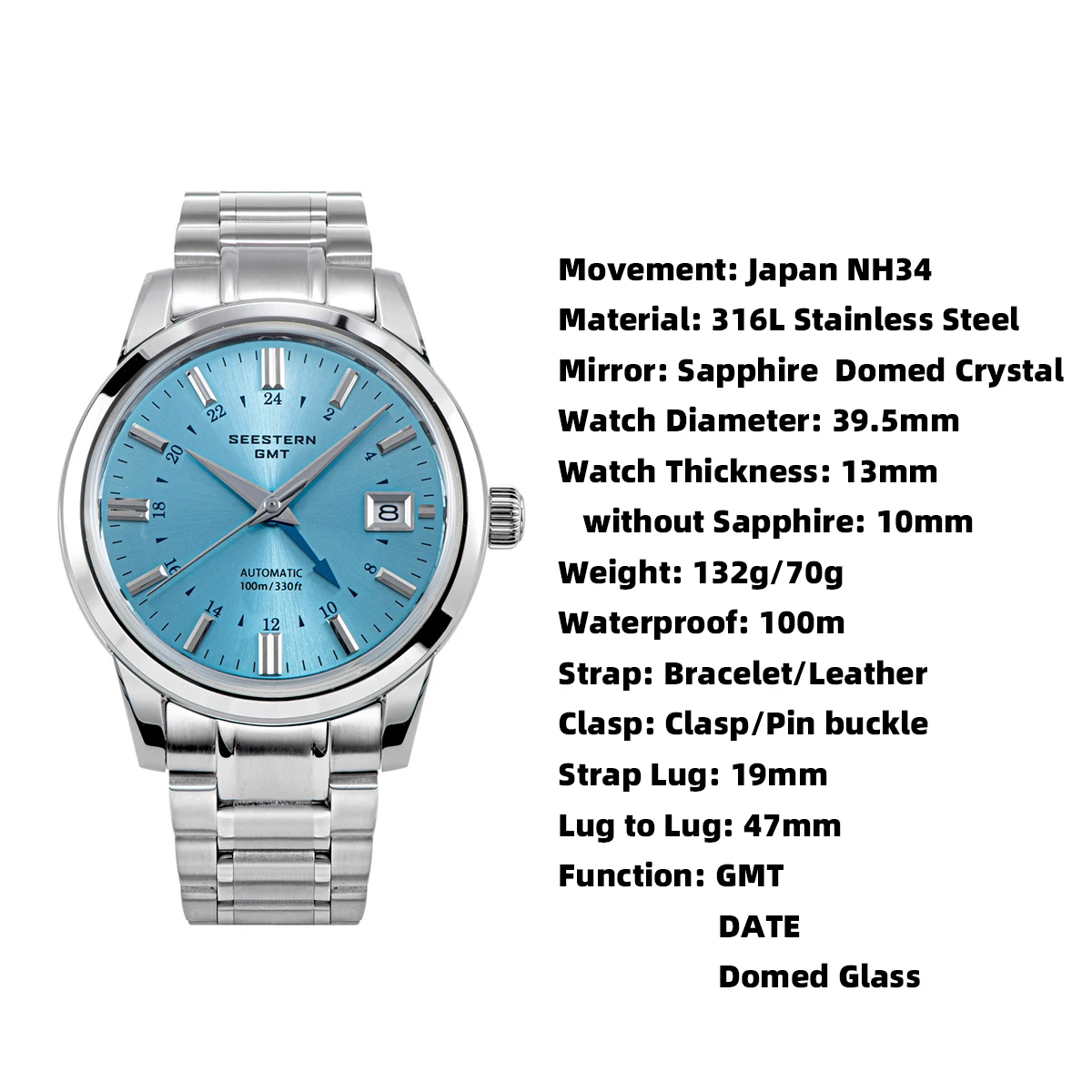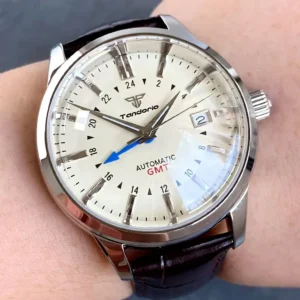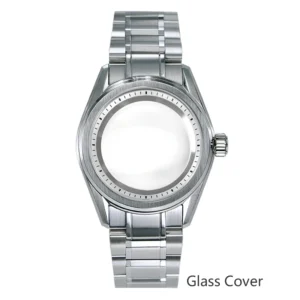1. Introduction: Two Distinct Watch Types for Different Needs
The world of automatic watches is filled with specialized timepieces designed for specific purposes. Among the most popular and distinctive are GMT watches and dive watches, each representing pinnacles of horological engineering.
GMT watches were born from the golden age of commercial aviation in the 1950s when pilots and travelers needed to track multiple time zones simultaneously. Their defining feature is an additional hand that completes one rotation every 24 hours, allowing the wearer to track a second time zone with ease.
Dive watches, on the other hand, emerged from the needs of underwater explorers and military divers who required reliable timekeeping in harsh aquatic environments. These robust timepieces are specifically engineered to withstand significant water pressure and provide crucial timing information during dives.
The key differences between these watches include:
- Primary function (time zone tracking vs. underwater timing)
- Bezel design and operation
- Water resistance capabilities
- Dial and hand configurations
- Case construction and durability
While both watch types represent different branches of horological innovation, understanding the GMT functionality in dive watches has become increasingly important as manufacturers combine these features. For watch enthusiasts looking to expand their collection, GMT automatic watches offer a perfect blend of practicality and sophisticated mechanics.
2. Primary Purpose: Function Defines Form
Every element of a watch’s design serves its intended purpose, and nowhere is this more evident than in the contrasting designs of GMT and dive watches.
Dive Watches: These timepieces are engineered with underwater survival and timing as their primary functions. Every design element revolves around legibility in low-light conditions, timing capability for oxygen supply management, and structural integrity under pressure. The ability to time a dive accurately can be a matter of life and death, making reliability paramount.
GMT Watches: Created specifically for international travelers, GMT watches focus on simultaneously tracking multiple time zones with clarity and precision. They originated when Pan American Airways commissioned a watch for pilots crossing multiple time zones, resulting in a design that prioritizes information display over extreme environmental resistance.
| Feature | Dive Watch | GMT Watch |
|---|---|---|
| Primary Function | Underwater timing and depth survivability | Multiple time zone tracking |
| Key Complication | Unidirectional timing bezel | 24-hour GMT hand |
| Professional Origin | Military and commercial diving | Commercial aviation |
| Modern Application | Water sports, diving, rugged everyday wear | Travel, business across time zones, everyday wear |
The functionality comparison between these two specialized timepieces reveals how GMT and dive watch functions differ fundamentally despite both being robust tool watches. This core difference in purpose drives every other aspect of their design.
3. Bezel Design: Different Tools for Different Jobs
The bezel—the rotating ring surrounding the watch face—is perhaps the most visibly different feature between GMT and dive watches, with each designed specifically for its primary function.
Dive Watch Bezels:
– Unidirectional rotation (counterclockwise only) as a safety feature—accidental movement can only make dive time appear longer, never shorter
– 60-minute graduated scale to time dives precisely
– Prominent, easy-to-read markers for the first 15-20 minutes (critical decompression timing)
– Luminous pip at zero marker for reference in dark underwater conditions
– Often made from ceramic or sapphire for scratch resistance in rugged environments
GMT Watch Bezels:
– Bidirectional rotation for easy adjustment when changing time zones
– 24-hour scale that works in conjunction with the GMT hand
– Frequently two-toned (such as blue/red or black/blue) to distinguish day hours from night hours
– Sometimes fixed (non-rotating) with the 24-hour scale printed on it
– More focus on legibility of numerals than on grip texture
These design differences aren’t merely aesthetic—they’re functional necessities. A dive watch bezel needs to be operated while wearing gloves underwater, so they typically feature pronounced ridges or knurling for grip. GMT bezels prioritize precision in setting and reading the 24-hour scale.
For enthusiasts seeking reliable underwater timing instruments, our selection of automatic dive watches showcases these specialized bezel designs that have become iconic in watchmaking.
4. Water Resistance: Depths vs. Practicality
When comparing GMT and dive watches, their water resistance capabilities represent one of the starkest contrasts.
Dive Watch Water Resistance:
– Minimum professional standard of 200m/660ft (many exceed this)
– Must comply with ISO 6425 standards for true dive watches
– Undergoes rigorous pressure testing, including condensation resistance checks
– Features reinforced case backs, thicker crystals, and multiple gaskets
– Often includes helium escape valves for professional saturation diving models
GMT Watch Water Resistance:
– Typically rated between 50m-100m/165ft-330ft
– Designed for occasional water exposure during travel
– Prioritizes everyday practicality over extreme depth capability
– May include screw-down crowns but with fewer water-resistant features
– Generally suitable for swimming but not for scuba diving
The difference in water resistance stems directly from each watch’s intended use. Dive watches must function as life-safety equipment underwater, while GMT watches need to withstand the rigors of international travel, including unexpected rain or pool splashes.
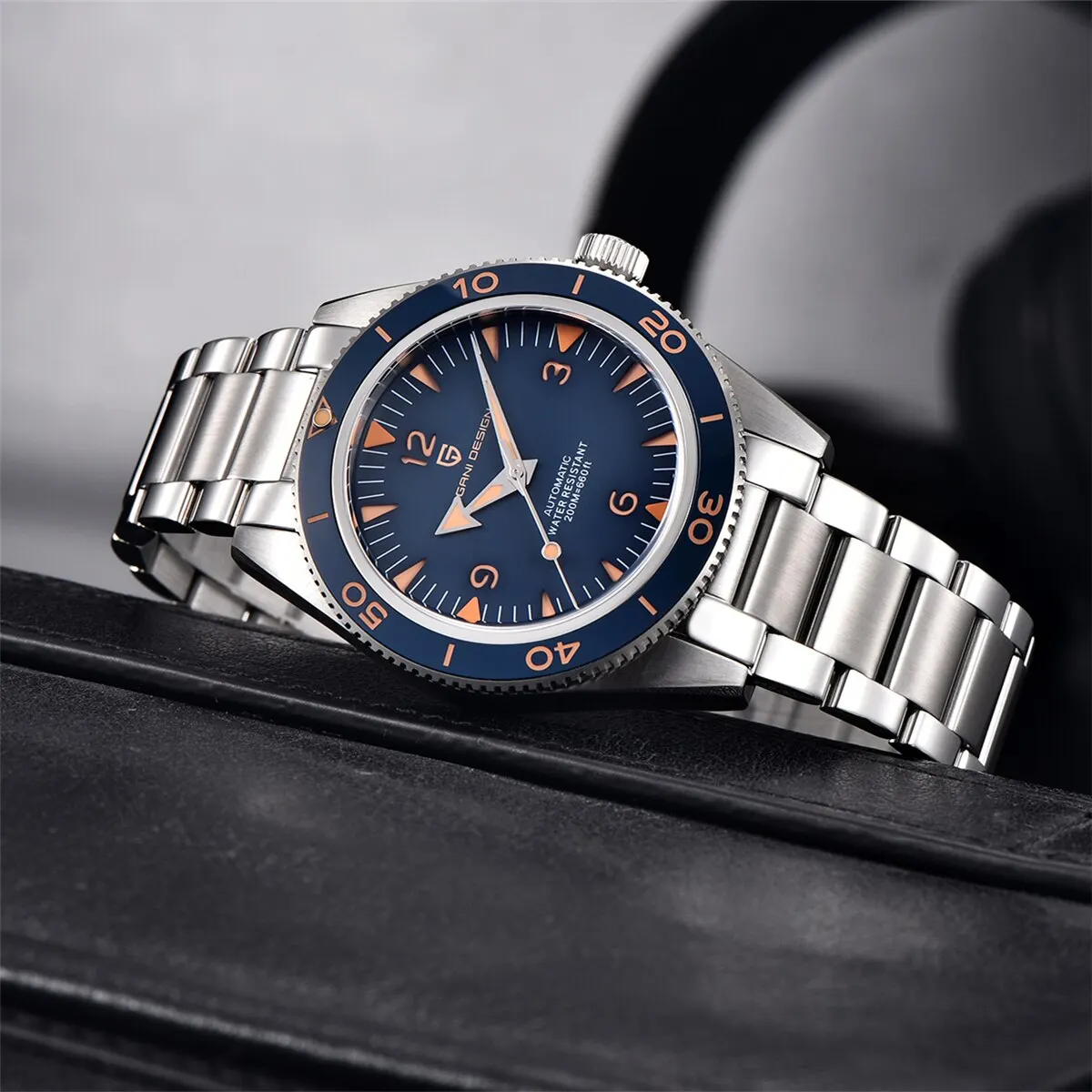
For those requiring true professional-grade water resistance, professional-spec dive watches offer enhanced depth ratings and durability features that exceed standard requirements.
5. Hands and Dial Features: Legibility vs. Information
The hands and dial design of both GMT and dive watches reflect their specialized purposes through distinct approaches to information display.
Dive Watch Hands and Dial:
– Oversized minute hand (crucial for timing dives accurately)
– High contrast between hands and dial (typically white or luminous hands on dark backgrounds)
– Substantial application of luminous material (SuperLuminova or similar) for underwater visibility
– Large, simple hour markers with minimal text to reduce visual clutter
– Clear differentiation between hour and minute hands to prevent confusion underwater
– Often feature a highly visible seconds hand to confirm the watch is running
GMT Watch Hands and Dial:
– Distinctive 24-hour hand (typically arrow-tipped or differently colored)
– Additional scale or markings for reading the 24-hour time
– Balance between providing multiple time zone information and maintaining readability
– Strategic use of color coding to differentiate between primary and secondary time zones
– Often more text and detail on the dial, including city names or time zone indicators
– Date complications frequently included for travel convenience
While dive watches prioritize instant legibility in potentially life-threatening situations, GMT watches focus on efficiently organizing multiple pieces of timing information on a single dial. Many travelers wonder if they can use a GMT watch for diving, but understanding these fundamental design differences helps explain why dedicated tools exist for each purpose.
6. Movement Considerations: Simple Reliability vs. Added Complications
The mechanical hearts of GMT and dive watches are engineered with their specialized functions in mind, leading to different priorities in movement design and functionality.
Dive Watch Movements:
– Emphasis on shock resistance and reliability under pressure
– Robust construction to withstand vibration and impact during active water sports
– Often feature simpler complications to minimize potential failure points
– Highly regulated for consistent accuracy regardless of position
– Stronger mainsprings and power reserves for reliable operation during extended dives
– Antimagnetic properties to resist interference from diving equipment
GMT Watch Movements:
– Additional complexity to drive the 24-hour GMT hand
– Often distinguished between “caller” GMT movements (where the GMT hand is independently set) and “traveler” GMT movements (where the local hour hand jumps in one-hour increments)
– Date mechanisms frequently linked to the GMT function for travelers
– Focus on precise adjustment capabilities for exact time zone settings
– Balance between added complications and everyday reliability
– Often featuring finer finishing as they’re frequently found in more dressy watch styles
The distinction between GMT and dual time watches lies primarily in their movement design and how they display multiple time zones. Where dual time watches typically feature two separate dials or subdials, true GMT watches integrate this function into a single dial with an additional hand.
7. Case Construction and Crown Design: Survival vs. Functionality
The external protection systems of GMT and dive watches reveal significant design differences based on their intended environments.
Dive Watch Cases and Crowns:
– Reinforced case backs, often thicker and sometimes with additional engravings or depth ratings
– Mandatory screw-down crowns with multiple gaskets to prevent water ingress
– Prominent crown guards to protect against impacts and accidental manipulation
– Helium escape valves on professional models to release built-up helium during decompression
– Cases often with minimal sharp edges that could catch on diving equipment
– Lug designs that accommodate wet suit extensions or quick-change options
GMT Watch Cases and Crowns:
– More balanced approach to case design, considering both function and aesthetics
– Crowns that may be screw-down or push-pull depending on intended water exposure
– Often more refined case finishing with polished and brushed surfaces
– Thinner profile for comfortable wear during long flights or business meetings
– Emphasis on ergonomics for frequent time adjustments when changing time zones
– Lug designs optimized for quick strap changes to match different travel attire

8. Materials and Durability: Environmental Considerations
The materials chosen for GMT and dive watches directly reflect the environments they’ll face and the functional demands placed upon them.
Dive Watch Materials:
– Highly corrosion-resistant metals like 316L stainless steel, titanium, or bronze (which develops a protective patina)
– Ceramic or sapphire bezel inserts that resist scratches from sand and underwater debris
– Specialized rubber or silicone straps designed to withstand saltwater exposure
– Metal bracelets with diver’s extensions to fit over wetsuits
– Extra-thick sapphire crystals to handle pressure changes
– Anti-reflective coatings to improve underwater visibility
GMT Watch Materials:
– Balance between durability and refined appearance
– Comfortable bracelet designs for long-haul travel
– Materials that pay homage to aviation heritage, such as brushed steel resembling aircraft components
– Often featuring more polished surfaces and decorative elements
– Lighter materials in some models for comfort during long periods of wear
– Crystals optimized for clarity across different lighting conditions encountered while traveling
For travelers who need both functions, GMT-dive watches combine materials that satisfy both sets of requirements, offering versatility for both underwater adventures and international journeys.
9. Hybrid Options: When You Need Both Functions
The watch industry has recognized that many enthusiasts desire both GMT and dive watch capabilities, leading to the development of hybrid models that combine these functionalities.
These GMT-Dive combination watches integrate both complications through several design approaches:
- Adding a GMT hand to a traditional dive watch format
- Maintaining dive watch water resistance while incorporating a 24-hour bezel
- Creating dual-purpose bezels with both timing and GMT markings
- Utilizing rotating inner bezels for one function while keeping the external bezel for another
- Developing more sophisticated movements that handle both complications efficiently
These hybrid designs provide notable advantages for travelers who also enjoy water sports, eliminating the need to switch watches between activities. However, they sometimes involve compromises, such as more complex dials that may sacrifice some underwater legibility or bezel designs that serve neither purpose perfectly.
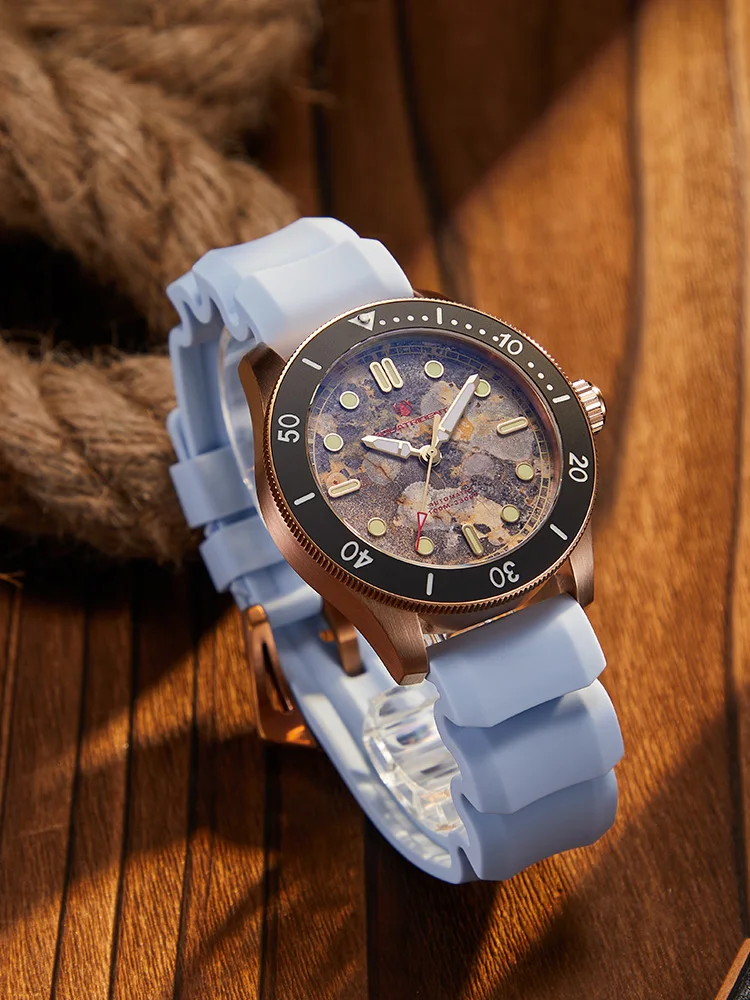
Understanding GMT complications in dive watches helps enthusiasts appreciate how watchmakers solve the engineering challenges of combining these different functionalities into a single timepiece.
10. Which Watch Type Is Right for You?
Choosing between a GMT watch and a dive watch ultimately depends on your lifestyle, activities, and personal preferences.
Lifestyle Considerations:
– Frequent international travelers may benefit more from a GMT watch’s multiple time zone tracking
– Active water sports enthusiasts and divers need the specialized features of a dive watch
– Professional requirements might dictate one type over the other (pilots vs. marine professionals)
– Everyday versatility might favor one style depending on your typical environments
Decision Factors:
– Primary use: Will you use the watch more for travel or water activities?
– Secondary features: Do you need precise dive timing or just general water resistance?
– Daily practicality: Which complications would you actually use regularly?
– Aesthetic preference: Which style appeals more to your personal taste?
Classic Automatic Dress Watches, GMT Automatic Watches, GMT Pilot Watches
Price range: $1,240.86 through $1,463.33 Select options This product has multiple variants. The options may be chosen on the product pageAutomatic Chronograph Watches, Classic Style Dive Watches
$3,053.06 Select options This product has multiple variants. The options may be chosen on the product pageBronze Automatic Watches, Military Inspired Automatic Watches, Professional Spec Dive Watches
Price range: $1,442.21 through $1,442.82 Select options This product has multiple variants. The options may be chosen on the product pageProfessional Spec Dive Watches, Titanium Automatic Watches
$574.74 Select options This product has multiple variants. The options may be chosen on the product pageClassic Automatic Dress Watches, GMT Automatic Watches, GMT Dive Watches
Price range: $468.93 through $552.94 Select options This product has multiple variants. The options may be chosen on the product pageGMT Automatic Watches, Unique Automatic Watches
$420.10 Select options This product has multiple variants. The options may be chosen on the product page
Both watch types offer distinct value propositions. GMT watches provide practical utility for today’s global citizens, while dive watches deliver robust durability with a tool-watch aesthetic that many find appealing even when not underwater.
For those who can’t decide, understanding various GMT dive watch use cases might help determine if a hybrid option better suits your needs.
11. Is a GMT Watch Waterproof?
While many people use the term “waterproof,” no watch is truly impervious to water under all conditions. The correct terminology is “water resistant,” and GMT watches typically offer moderate water resistance suitable for everyday situations.
Most GMT watches provide water resistance in the 50-100 meter range (165-330 feet). This rating means they can handle:
– Rain and accidental splashes
– Washing hands and brief immersion in water
– Swimming in most cases (though not all GMT watches)
– Snorkeling for models with 100m ratings
However, several factors affect water resistance over time, including:
– Aging gaskets that require periodic replacement
– Impact damage that might compromise seals
– Crown position during water exposure (should always be fully closed)
– Temperature changes that can affect case expansion and contraction
For those primarily interested in aviation themes with some water resistance, GMT pilot watches typically balance these features with design elements that honor their cockpit heritage.
12. Can You Dive With a GMT Watch?
While GMT watches often feature respectable water resistance, they generally aren’t suitable for scuba diving. This limitation stems from several factors beyond just depth ratings:
- Most GMT watches lack the unidirectional timing bezel critical for monitoring dive time and air supply
- They typically aren’t tested to the rigorous ISO 6425 diving watch standards
- Their crowns and case construction may not be engineered for sustained underwater pressure
- Luminosity is usually insufficient for low-light underwater conditions
For recreational swimming, pool use, and snorkeling, most GMT watches with 100m water resistance will perform adequately. However, for actual scuba diving, a proper dive watch or dive computer remains the appropriate tool for safety reasons.
If you occasionally dive but primarily need GMT functionality, considering a hybrid model might be your best option rather than compromising on safety features.
13. What Makes a Watch a True GMT Watch?
Not all watches with multiple time zone functions are created equal. A “true GMT” or “traveler’s GMT” watch has specific functionality that distinguishes it from simpler dual-time watches:
- An independent hour hand that can be adjusted in one-hour increments without stopping the watch
- The ability to quickly reset the local time when changing time zones without affecting the minute hand or seconds hand
- A 24-hour hand that maintains home time reference
- Date function that advances with the local hour hand
This contrasts with “caller GMT” or “office GMT” watches, where:
– The GMT hand is independently adjustable
– The main hour hand remains fixed to home time
– Changing local time requires moving the bezel or adjusting the GMT hand
The practical benefit of a true GMT mechanism becomes apparent when traveling across time zones. Upon landing, you can adjust only the hour hand to local time while maintaining accurate minutes and seconds, and without losing track of your home time on the 24-hour hand.
14. Conclusion: Specialized Tools for Different Journeys
GMT and dive watches represent the fascinating way horology has evolved to meet specific human needs—whether navigating across time zones or exploring beneath the waves. Their differences in design, from bezels to water resistance to dial configurations, all stem from their distinct purposes.
Dive watches excel as specialized timing instruments capable of withstanding extreme underwater conditions, prioritizing reliability and legibility when they’re needed most. GMT watches serve as practical companions for the global traveler, elegantly solving the problem of tracking multiple time zones with mechanical ingenuity.
Understanding these differences not only helps in selecting the right watch for your needs but also deepens appreciation for how form follows function in fine watchmaking. Each represents a pinnacle of specialized mechanical engineering, showcasing how watches remain relevant tools even in our digital age.
Whether you choose a dedicated dive watch, a GMT timepiece, or one of the increasingly popular hybrid models, you’re wearing a piece of functional history on your wrist—a testament to human ingenuity in solving practical problems through mechanical means.

